Himalayan pink salt is widely appreciated in kitchens around the world for its delicate flavor and unique mineral content, but its uses extend far beyond cooking. While most people associate it with seasoning meats, vegetables, or fish, pink salt also has surprising applications around the home, including one particularly unusual but effective method: placing it in the corners of rooms to ward off unwanted visitors, both figuratively and literally.
Himalayan Pink Salt in the Kitchen
Many chefs and home cooks prefer Himalayan pink salt to regular sea or table salt. Its lower salinity provides a milder, less harsh taste, making it ideal for dishes that don’t require heavy seasoning. Rich in potassium and iron, this salt enhances the flavors of a variety of foods, from roasted vegetables to seafood and meats. However, because it dissolves more slowly than conventional salts, it’s less suitable for broths, soups, or stocks.
The salt is mined from the Khewra Salt Mine in Pakistan, a region near the famous Himalayas. While the name evokes the majestic mountain range, the salt itself is harvested manually and remains unrefined, maintaining its natural mineral composition. The distinctive pink hue, which can range from soft blush to almost white, comes from the iron content present in the salt.
Beyond Culinary Uses
Although Himalayan pink salt has earned a reputation for culinary excellence, its benefits and applications go beyond the kitchen. In recent years, it has become popular in wellness and decorative contexts as well. Many people use pink salt in bath soaks, soaps, and even lamps, believing in its potential to improve air quality and overall well-being.
The unique properties of this salt have led to the creation of ornamental items, such as salt lamps and decorative blocks, which are both aesthetically pleasing and purported to have certain health benefits. Whether these benefits are purely symbolic or practical, the presence of pink salt in the home has become a common sight.
Placing Pink Salt in Home Corners
One of the more unusual but practical uses of Himalayan pink salt is to place it in the corners of rooms. This practice is rooted in both traditional beliefs and practical pest control. Many people believe that pink salt can absorb negative energy, purify the air, and create a protective barrier against harmful influences. While some of these claims are more anecdotal than scientifically proven, there is one very real, practical effect: the salt can help keep spiders away.
Sprinkling small amounts of pink salt in corners, along baseboards, or near windows can deter spiders and other minor household pests. The coarse grains are abrasive to these small creatures, making certain areas less hospitable for them to settle or build webs. This simple practice offers a natural, chemical-free alternative to commercial pest sprays, making it safe for use around children and pets.
Spiritual and Traditional Uses
Beyond its pest-repelling qualities, Himalayan pink salt has long been used in various cultural and spiritual practices. In Himalayan traditions, it is believed to cleanse spaces of negative energies, enhance mood, and create a sense of balance. Some rituals involve sprinkling salt around a room to ward off bad luck or malevolent spirits, while others use it to neutralize the effects of electronic devices by absorbing harmful electromagnetic radiation.
Even though some of these uses may seem rooted in superstition, many people report a heightened sense of well-being and calm when Himalayan pink salt is used in their homes. Whether for spiritual reasons or simply as a decorative element, its presence has a positive psychological effect.
Tips for Using Pink Salt in the Home
If you want to try this unusual application, here’s how to do it effectively:
-
Identify problem corners: Place small amounts of pink salt in corners where spiders are likely to appear, such as along walls, near windows, or under furniture.
-
Use coarse grains: Coarse pink salt works better than fine powder for pest deterrence, as it creates a physical barrier.
-
Refresh regularly: Over time, the salt can absorb moisture or dust. Replace it every few weeks to maintain effectiveness.
-
Combine with other practices: Open windows regularly to ventilate rooms and reduce humidity, which also helps deter spiders. Additionally, keeping surfaces clean and free from crumbs or debris enhances the overall effect.
Decorative and Aesthetic Advantages
Besides its practical uses, Himalayan pink salt adds an aesthetic appeal to your home. The soft pink hue creates a natural, calming look, whether sprinkled in corners or displayed in decorative bowls. Pairing it with candles, crystals, or small ornamental pieces can enhance its visual impact while maintaining its practical benefits.
A Simple, Multi-Purpose Element
Himalayan pink salt is one of those rare household items that bridges practicality, aesthetics, and tradition. It can season food, improve wellness rituals, repel pests, and add a decorative touch to any space. While its spiritual or energy-related properties may be up for debate, its ability to deter spiders and contribute to a cleaner, more organized home environment is tangible.
Incorporating pink salt into your household routine is simple. By sprinkling a small amount in strategic corners, you can create a subtle, natural barrier against pests while also benefiting from its mineral-rich composition and gentle aesthetic. Over time, this inexpensive and eco-friendly solution can become a versatile addition to your cleaning and wellness toolkit.
Conclusion
Himalayan pink salt is much more than a culinary ingredient. From its mild flavor and mineral content to its decorative, spiritual, and practical applications, it has become a valuable tool in modern homes. Placing a handful in the corners of your rooms not only connects to traditional beliefs but also provides a simple, natural method for keeping unwanted pests like spiders at bay. Whether you use it for cooking, decoration, or home care, pink salt is a multi-purpose asset worth keeping close at hand.



